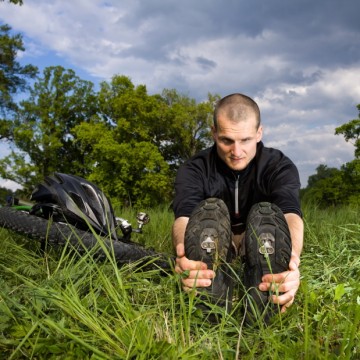Off Your Bike: Four Helpful Stretches for the Bike Commuter
Thursday, October 30, 2014

Photo credit: iStock
Cycling, although a fantastic means of exercise, comes with its own risks of overuse injury.
Biking requires constant repetitive motion which puts you at risk for tendonitis and strain in various muscle groups. You also do not complete a full range of motion with any of your lower extremity muscles while biking, and this opens you up for lots of tightness in major muscle groups, and that could lead to chronic discomfort that seeps into all areas of your life.
It is generally recommended that you do a warm-up prior to biking. The warm-up could look like one of two things: A) going through a round of yoga sun salutations, which is ideal as it puts your muscles through a full range of motion, and is fluid stretching, or B) using the first 10 minutes of your commute as your warm-up.
This article is not about warm-ups. This is about beginning a stretching habit so that you can maintain the health and integrity of the major areas of vulnerability that bike commuting creates. These are not the “4 Most Important Stretches for Cyclists.” The most important stretches for you should be based on your problem areas. These four stretches were chosen because they are helpful for everyone who rides a bike, and they can help prevent some of the most common bike riding injuries: Achilles tendonitis, patellar tendonitis, IT Band Syndrome, and low back pain.
These stretches should be done until you feel pulling in the targeted muscle group, but no pain. This position should then be held until you feel the muscle start to relax. The usual duration needed to accomplish this is somewhere between 20 and 60 seconds. Each stretch should be done 3 times, and this routine should be done 3-4 times/week outside of your regular exercise /biking schedule.
Quadriceps Stretch
From a standing position, find a fixed point on the floor to focus on or hold onto a wall so you can keep your balance. Bend your right knee, moving your right heel towards your butt. Point your right toe, and grab your right ankle with your right hand. Get your heel as close to your butt as you are able. Be mindful of engaging your core and do not arch your back. Ease out of the stretch, then repeat on the other leg. If you are in need of a more intense quadriceps stretch, you can check out this yoga-inspired stretch.
IT Band Stretch
The IT Band is a band of muscles that runs down the outside of your leg, from your hip to your knee (the muscles involved, however, also include your glutes and muscles that run below your knee). Tightness in this band is a very common cause of knee pain. It also happens to be very difficult to stretch. Click the next phrases for some different IT stretches that claim to be “the best:” Back-lying IT stretch. Side-lying IT stretch. Yoga-based IT stretch. The ideal way to treat IT band tightness at home is to roll the muscles with a foam roller. Here is a great video about the correct way to roll to treat tightness at the upper end of the IT band.
Heel Drops
This stretch works on the calves, achilles tendon, and ankles. The basic form of this stretch is done by standing on the edge of a step, standing at the top of a calf-raise (on your tip-toes). Shift all of your weight to one leg (the injured one if you already have achilles tendonitis), and slowly (and in control) use your calf muscles to lower your body down so that your heel is below the top of the step. Slowly return to the start position (if you already have an injury, use the opposite foot to return yourself to the starting position or you will risk further injury). If you already have an achilles injury, this exercise will be moderately painful, and according to this website, that is ok as long as it is not “excruciating.” For stretching purposes, repeat on the other leg.
Kneeling Lunge
This stretches those ever-tight hip flexors, and can help prevent low back pain. Begin by standing on both knees, straight and upright, with the tops of your feet flat on the floor behind you. Bring your right foot forward and place it flat on the floor with your leg bent at 90 degrees. Keep your right knee over your right ankle. At this point you can slowly lean forward, placing most of your weigh on your right leg, keeping your back straight (even if leaning forward over the knee), and placing your hands either on your right thigh or on the ground next to your right foot. If this is not enough of a stretch in the front of your thigh, you can slightly shift your left knee further back, creating a wider lunge stance so there is more stretch. Click here for a short video showing correct form.
As a reminder, doing any stretches incorrectly, or doing stretches that compromise already injured parts of your body, can cause or further injury. These are basic stretches that most people can do safely, but these suggestions are not intended to take the place of a correct assessment and treatment plan from a qualified health care provider.

Banner Photo Credit: iStock
Related Articles
- Coffee: Virtue or Vice?
- Do Probiotics Live Up To The Hype?
- Backyard Medicine: 4 Plants You Should Add to Your Medicine Cabinet
- Four Ways Your Office Job Is Hurting You And What to Do About it
- Hey, Sleepyhead! Three Surefire Ways to Improve Your Sleep
- School Bugs: 5 Ways to Boost Your Family’s Health During the School Year
- Soy: A Dangerous Love Affair
- Sweet temptation: Eight Ways to Tame the Sugar Beast




 Delivered Free Every
Delivered Free Every
Follow us on Pinterest Google + Facebook Twitter See It Read It